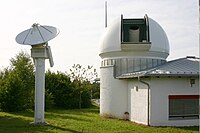
Photo from wikipedia
Cohesive Distributed Satellite Systems (CDSSs) is a key enabling technology for the future of remote sensing and communication missions. However, they have to meet strict synchronization requirements before their use… Click to show full abstract
Cohesive Distributed Satellite Systems (CDSSs) is a key enabling technology for the future of remote sensing and communication missions. However, they have to meet strict synchronization requirements before their use is generalized. When clock or local oscillator signals are generated locally at each of the distributed nodes, achieving exact synchronization in absolute phase, frequency, and time is a complex problem. In addition, satellite systems have significant resource constraints, especially for small satellites, which are envisioned to be part of the future CDSSs. Thus, the development of precise, robust, and resource-efficient synchronization techniques is essential for the advancement of future CDSSs. In this context, this survey aims to summarize and categorize the most relevant results on synchronization techniques for Distributed Satellite Systems (DSSs). First, some important architecture and system concepts are defined. Then, the synchronization methods reported in the literature are reviewed and categorized. This article also provides an extensive list of applications and examples of synchronization techniques for DSSs in addition to the most significant advances in other operations closely related to synchronization, such as inter-satellite ranging and relative position. The survey also provides a discussion on emerging data-driven synchronization techniques based on Machine Learning (ML). Finally, a compilation of current research activities and potential research topics is proposed, identifying problems and open challenges that can be useful for researchers in the field.
Journal Title: IEEE Access
Year Published: 2022
Link to full text (if available)
Share on Social Media: Sign Up to like & get
recommendations!